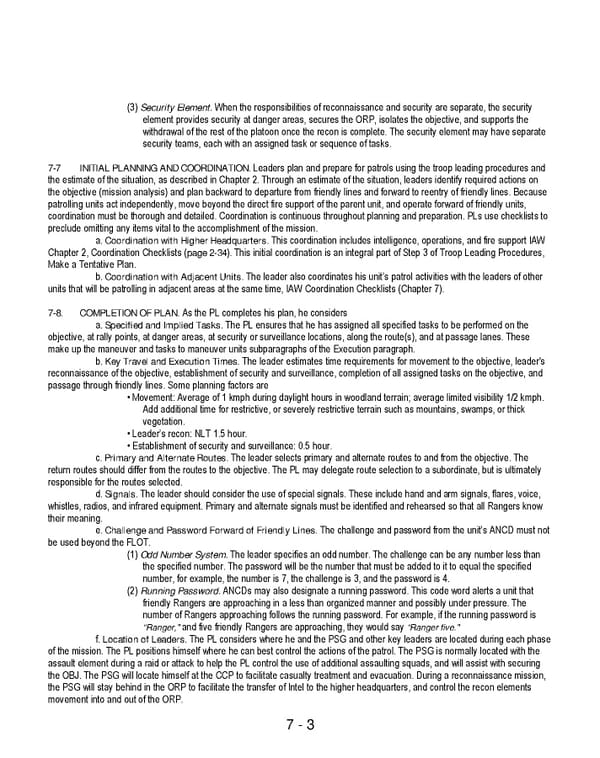7 - 3 (3) Security Element. When the responsibilities of reconnaissance and security are separate, the security element provides security at danger areas, secures the ORP, isolates the objective, and supports the withdrawal of the rest of the platoon once the recon is complete. The security element may have separate security teams, each with an assigned task or sequence of tasks. 7-7 INITIAL PLANNING AND COORDINATION. Leaders plan and prepare for patrols using the troop leading procedures and the estimate of the situation, as described in Chapter 2. Through an estimate of the situation, leaders identify required actions on the objective (mission analysis) and plan backward to departure from friendly lines and forward to reentry of friendly lines. Because patrolling units act independently, move beyond the direct fire support of the parent unit, and operate forward of friendly units, coordination must be thorough and detailed. Coordination is continuous throughout planning and preparation. PLs use checklists to preclude omitting any items vital to the accomplishment of the mission. a. Coordination with Higher Headquarters. This coordination includes intelligence, operations, and fire support IAW Chapter 2, Coordination Checklists (page 2-34). This initial coordination is an integral part of Step 3 of Troop Leading Procedures, Make a Tentative Plan. b. Coordination with Adjacent Units. The leader also coordinates his unit’s patrol activities with the leaders of other units that will be patrolling in adjacent areas at the same time, IAW Coordination Checklists (Chapter 7). 7-8. COMPLETION OF PLAN. As the PL completes his plan, he considers a. Specified and Implied Tasks. The PL ensures that he has assigned all specified tasks to be performed on the objective, at rally points, at danger areas, at security or surveillance locations, along the route(s), and at passage lanes. These make up the maneuver and tasks to maneuver units subparagraphs of the Execution paragraph. b. Key Travel and Execution Times. The leader estimates time requirements for movement to the objective, leader's reconnaissance of the objective, establishment of security and surveillance, completion of all assigned tasks on the objective, and passage through friendly lines. Some planning factors are • Movement: Average of 1 kmph during daylight hours in woodland terrain; average limited visibility 1/2 kmph. Add additional time for restrictive, or severely restrictive terrain such as mountains, swamps, or thick vegetation. • Leader’s recon: NLT 1.5 hour. • Establishment of security and surveillance: 0.5 hour. c. Primary and Alternate Routes. The leader selects primary and alternate routes to and from the objective. The return routes should differ from the routes to the objective. The PL may delegate route selection to a subordinate, but is ultimately responsible for the routes selected. d. Signals. The leader should consider the use of special signals. These include hand and arm signals, flares, voice, whistles, radios, and infrared equipment. Primary and alternate signals must be identified and rehearsed so that all Rangers know their meaning. e. Challenge and Password Forward of Friendly Lines. The challenge and password from the unit’s ANCD must not be used beyond the FLOT. (1) Odd Number System. The leader specifies an odd number. The challenge can be any number less than the specified number. The password will be the number that must be added to it to equal the specified number, for example, the number is 7, the challenge is 3, and the password is 4. (2) Running Password. ANCDs may also designate a running password. This code word alerts a unit that friendly Rangers are approaching in a less than organized manner and possibly under pressure. The number of Rangers approaching follows the running password. For example, if the running password is “Ranger," and five friendly Rangers are approaching, they would say “Ranger five." f. Location of Leaders. The PL considers where he and the PSG and other key leaders are located during each phase of the mission. The PL positions himself where he can best control the actions of the patrol. The PSG is normally located with the assault element during a raid or attack to help the PL control the use of additional assaulting squads, and will assist with securing the OBJ. The PSG will locate himself at the CCP to facilitate casualty treatment and evacuation. During a reconnaissance mission, the PSG will stay behind in the ORP to facilitate the transfer of Intel to the higher headquarters, and control the recon elements movement into and out of the ORP.
 Ranger Handbook Page 114 Page 116
Ranger Handbook Page 114 Page 116